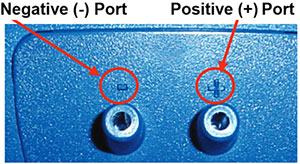October 1, 2013
2064 view(s)
Using a TSI VelociCalc for pressure testing
We occasionally get questions about how to do differential and static pressure testing with the TSI VelociCalc 9555 and 9565 air velocity meters. It's actually pretty simple.
For differential pressure testing:
- Connect the two lengths of neoprene tubing to the positive and negative ports at the top of the
 instrument
instrument - Place the free end of the positive port tubing in the area being tested
- Place the free end of the negative port tubing in the control/ambient zone
- A positive reading means the variable/sample (+) zone is higher pressure than the control/ambient (-)
- A negative reading means the control/ambient zone (-) is higher pressure than the variable/sample (+) zone
For static pressure testing:
- Connect one length of neoprene tubing to the positive port at the top of the instrument
- Keep the negative (-) port open to measure ambient conditions
- Attach the static pressure tip to the tubing on the positive (+) port
- Point the static pressure tip directly into airflow to get an accurate reading
- Positive reading means the pressure in the duct is higher than the measured ambient conditions
- Negative reading means the pressure in the duct is lower than the measured ambient conditions
For more tips on using the VelociCalc 9565, go here.
